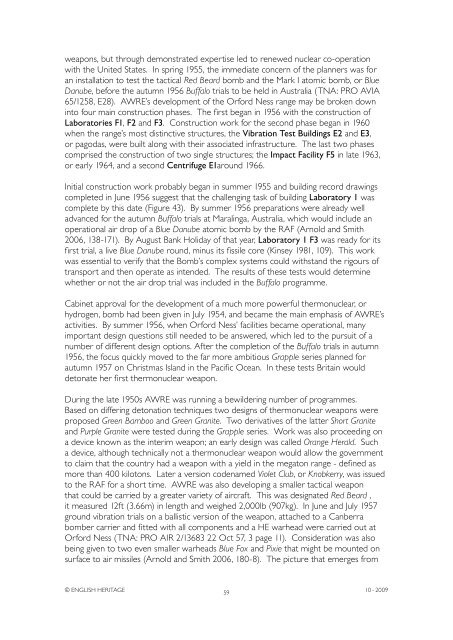Atomic Weapons Research Establishment. Orford ... - English Heritage
Atomic Weapons Research Establishment. Orford ... - English Heritage
Atomic Weapons Research Establishment. Orford ... - English Heritage
Create successful ePaper yourself
Turn your PDF publications into a flip-book with our unique Google optimized e-Paper software.
weapons, but through demonstrated expertise led to renewed nuclear co-operation<br />
with the United States. In spring 1955, the immediate concern of the planners was for<br />
an installation to test the tactical Red Beard bomb and the Mark I atomic bomb, or Blue<br />
Danube, before the autumn 1956 Buffalo trials to be held in Australia (TNA: PRO AVIA<br />
65/1258, E28). AWRE’s development of the <strong>Orford</strong> Ness range may be broken down<br />
into four main construction phases. The first began in 1956 with the construction of<br />
Laboratories F1, F2 and F3. Construction work for the second phase began in 1960<br />
when the range’s most distinctive structures, the Vibration Test Buildings E2 and E3,<br />
or pagodas, were built along with their associated infrastructure. The last two phases<br />
comprised the construction of two single structures; the Impact Facility F5 in late 1963,<br />
or early 1964, and a second Centrifuge E1around 1966.<br />
Initial construction work probably began in summer 1955 and building record drawings<br />
completed in June 1956 suggest that the challenging task of building Laboratory 1 was<br />
complete by this date (Figure 43). By summer 1956 preparations were already well<br />
advanced for the autumn Buffalo trials at Maralinga, Australia, which would include an<br />
operational air drop of a Blue Danube atomic bomb by the RAF (Arnold and Smith<br />
2006, 138-171). By August Bank Holiday of that year, Laboratory 1 F3 was ready for its<br />
first trial, a live Blue Danube round, minus its fissile core (Kinsey 1981, 109). This work<br />
was essential to verify that the Bomb’s complex systems could withstand the rigours of<br />
transport and then operate as intended. The results of these tests would determine<br />
whether or not the air drop trial was included in the Buffalo programme.<br />
Cabinet approval for the development of a much more powerful thermonuclear, or<br />
hydrogen, bomb had been given in July 1954, and became the main emphasis of AWRE’s<br />
activities. By summer 1956, when <strong>Orford</strong> Ness’ facilities became operational, many<br />
important design questions still needed to be answered, which led to the pursuit of a<br />
number of different design options. After the completion of the Buffalo trials in autumn<br />
1956, the focus quickly moved to the far more ambitious Grapple series planned for<br />
autumn 1957 on Christmas Island in the Pacific Ocean. In these tests Britain would<br />
detonate her first thermonuclear weapon.<br />
During the late 1950s AWRE was running a bewildering number of programmes.<br />
Based on differing detonation techniques two designs of thermonuclear weapons were<br />
proposed Green Bamboo and Green Granite. Two derivatives of the latter Short Granite<br />
and Purple Granite were tested during the Grapple series. Work was also proceeding on<br />
a device known as the interim weapon; an early design was called Orange Herald. Such<br />
a device, although technically not a thermonuclear weapon would allow the government<br />
to claim that the country had a weapon with a yield in the megaton range - defined as<br />
more than 400 kilotons. Later a version codenamed Violet Club, or Knobkerry, was issued<br />
to the RAF for a short time. AWRE was also developing a smaller tactical weapon<br />
that could be carried by a greater variety of aircraft. This was designated Red Beard ,<br />
it measured 12ft (3.66m) in length and weighed 2,000lb (907kg). In June and July 1957<br />
ground vibration trials on a ballistic version of the weapon, attached to a Canberra<br />
bomber carrier and fitted with all components and a HE warhead were carried out at<br />
<strong>Orford</strong> Ness (TNA: PRO AIR 2/13683 22 Oct 57, 3 page 11). Consideration was also<br />
being given to two even smaller warheads Blue Fox and Pixie that might be mounted on<br />
surface to air missiles (Arnold and Smith 2006, 180-8). The picture that emerges from<br />
© ENGLISH HERITAGE<br />
59<br />
10 - 2009

















